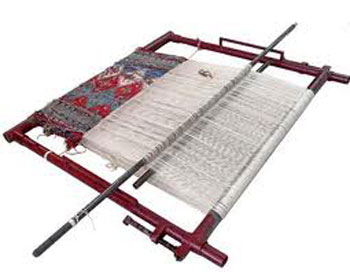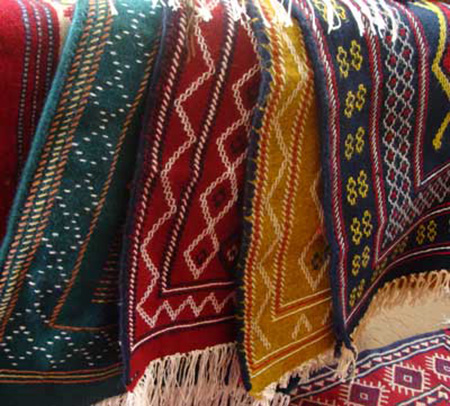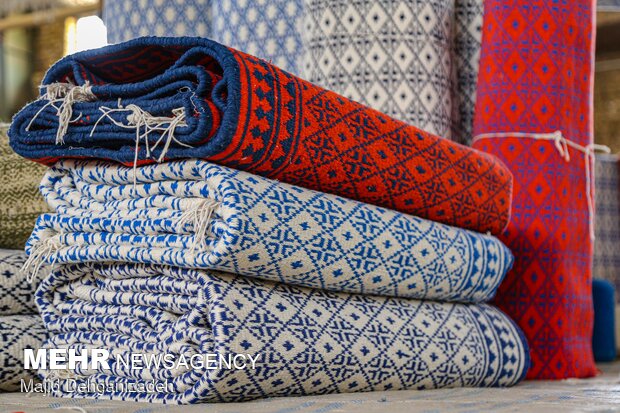A kilim is a type of carpet without piles, which is created by the contact of taropods with each other. Usually, its warp is cotton and wool, and sometimes it is silk, and its weft is made of wool, fluff and silk threads. This kilim has different names in Persian language. Galim in Afghanistan - Gilim in Ukraine - Badas in the Caucasus - Liat in Syria and Lebanon - Chilim in Romania as well as Kilim in Turkey, Poland, Hungary and Saudi Arabia are among the different names.
The history of kilim weaving
Since ancient times, humans have used the skins of the animals they hunted to cover and protect the body against weather changes and as a mattress, and gradually with the spread of animal husbandry and wool spinning, weaving became popular among primitive tribes and is one of the It was considered the first tribal arts and crafts.kilim bag
Although it is not clear where and by which people and tribes the first cloths were woven, which coincided with the beginning of kilim weaving, but based on archaeological excavations, there are evidences of weaving among the inhabitants of the Iranian plateau and neighboring lands. Obtained. For example, in the southeast caves of the Mazandaran Sea (Kinzwar Cave and Hutto near Behshahr), traces were found that prove that the people of this region used to raise sheep and goats and spin their wool and hair 8000 years ago.
Also, an 8000-year-old piece of fabric woven from goat hair was found on the shores of the Mazandaran sea, and a 6000-year-old linen cloth was found in Susa.
With all these evaluations, it is not possible to provide an exact date for the kilim . The oldest discovered kilim in the world called Pazyrik belongs to 350-500 BC.
kilim weaving was an introduction to kilim weaving. The date of the beginning of kilim weaving has been estimated at 1500-2000 BC, it can be said that the date of the beginning of carpet weaving was around 3000-5000 BC.
kilim weaving machines
In general, there are four types of tissue devices:

A- Simple woven kilim
The simple woven kilim machine is made of an auxiliary piece of wood and the kilim is woven uniformly on it. The back and the surface of this type of kilim are the same and both surfaces can be used.
B- The spinning kilim weaving
machine has four cages. Each layer is moved by means of bows. In this type of weaving, all the threads are passed from layer to layer. The weaving proceeds in the same way. On the back of the rug, additional wefts are placed on top of each other, and for this reason, the result will be a strong and thick rug with a different back and face, which can only be used on one side.
C- Jajim weaving
machine Jajim weaving machine has four cages and several bows. The main difference between Jajim and other types of rugs is the color of its threads, which are effective in the emergence of patterns like a weft.
D- Needle kilim (sumak) The needle kilim
machine has a needle and is generally similar in appearance to a simple kilim weaving machine. In this weave, extra wefts remain free at the back of the kilim . The texture of this type of kilim is between Nomads are very common. It is often used for decoration.
Before buying iran handicrafts rugs, it is better to be familiar with its types of texture.
Types of kilim fabrics in Iran
Shiriki Pich (Shirki Pich):
Shiriki Pich is the name given to it by the nomadic and rural weavers of Kerman. It looks like a kilim and is woven with knots like a kilim , and unlike other types of rugs, the weft complements and highlights its patterns. The weft only connects the threads to each other and is hidden behind the meat (piles) of the rug and cannot be seen. Patterns are created by means of a knot that is tied on the thread. The text knot, with the help of which the colored thread passes over the two threads and is turned back and passes under the main thread and creates a knot. The second knot is the diving knot. In this knot, the colored weft is placed twice Two threads are placed and it creates a wider line. After finishing the knotting operation, wefting is done in each row and a conflict is created between the weft and the knots.
Shiriki Pich motifs rise above the geometric limit and sometimes achieve balance and harmony from the combination of asymmetric motifs. The motif of the jake plant can be seen among the twisted Shiriki motifs, in which two round flowers are embedded, which are symmetrical to each other. The borders are often chained and composed of a repeated geometric shape, which are placed between two parallel lines. They are called circular margins. The flower is a Kashmiri text that fills the whole text with its repetition. Other motifs that are common in the texture of this product are: Kara, Shah Abbasi flower, Kermani flower and Jaft flower. The chosen colors of Shiriki Pich weavers are usually dark colors. Another type of border is the wakili border, which is usually red in the middle of the small circles inside the flower and its background is green.
Varni:
Varni is a rug-like rug that is produced without a plan and mentally by the women and girls of the Mughan Plain and the nomads of the suburbs of Ahar, Arsbaran and Mishkin Shahr (in East Azerbaijan Province). which is printed on it is an indicator of the environment and its reflection in the minds of nomadic women and girls. Most of the motifs are influenced by the shapes of animals and wild animals of the region, and the main motifs of animals are deer, deer, wolf, herd dog, turkey, chicken and Roosters, cats, snakes, eagles, sheep, tigers, camels, foxes, jackals, peacocks, and local birds that are woven in simple geometric patterns.
Varnish colors have a lacquered background, navy blue, cream, white, onion and light blue with animal designs in the middle and a maximum width of 20 cm on the sides.
Glimcheh:
It is another type of Iranian rugs that is prepared in Bijar and the surrounding villages of Sanandaj using weaving method and other raw materials. Its difference from ordinary rugs is that it is small and its motifs are more diverse than rugs, as Kurdistan rugs mostly have simple shapes and their motifs are mostly in the form of horizontal lines, while Kurdistan rugs often have diverse motifs.
In the villages of the sari parts, a type of kilim is woven with cotton thread and wool weft in the dimensions of 70 x 110 cm.

Zylo:
In most rural areas, it is woven with cotton thread and is mostly used as a summer undergarment. In most places, Zylo is woven with weaving machines, but in the rural areas of Tehran, Saveh, Kashan and Yazd cities. It is woven in the same way as a rug. It has a rough appearance and cannot be compared with other types of rugs in terms of variety of colors and patterns. The main raw material of zilo bafi is spun cotton thread, and usually 6 to 8 threads are placed next to each other in one layer and are spun and used for weft.

Pelas or Pallas:
It looks like a coarse rug and is produced in some areas, such as Yazd.

Masnad:
In the villages of Namin sector of Ardabil city, a type of kilim with small dimensions (100 x 150 cm) is woven, which is called Masnad, and its weaving history reaches 50 years in this place. Musnad has local designs and has special elegance and beauty.
Jol:
In the beginning, there are designs in the form of needlework, on which a simple background texture is sewn after completion. These types of fabrics can be used on one side and have a back and a front. The gel is used to cover the sweaty ends.
Sajjadah:
It is woven only for praying and has a role close to that of a kilim altar, and due to its small size and lightness, the prayer person can carry it with him.
Chig: It is used for the wall of the tent by dividing the tents
in most of the islands . Chigs have no back and front and have the same beauty on both sides. The special motifs of chigs are the same as the traditional patterns of rugs, which have changed according to the weaving method, due to the large unit of weaving in the chig.
Kuche:
It is a type of underlay, meaning white or gray felt, which is used to cover the walls of tents.
Ensi:
A special kilim used to cover furniture.
kilim :
kilim is also used to cover household furniture such as bedding and other essentials of life and travel, and now it exists only in the tribes that still continue their nomadic life.

Javal:
It is big bags and (Tobra) or Turba. These bags are hung on the wall by the tent dwellers. Jwal is a kind of food storage.
Khorjin:
It is the braids that the tent dwellers carry with them.
- ۰ ۰
- ۰ نظر